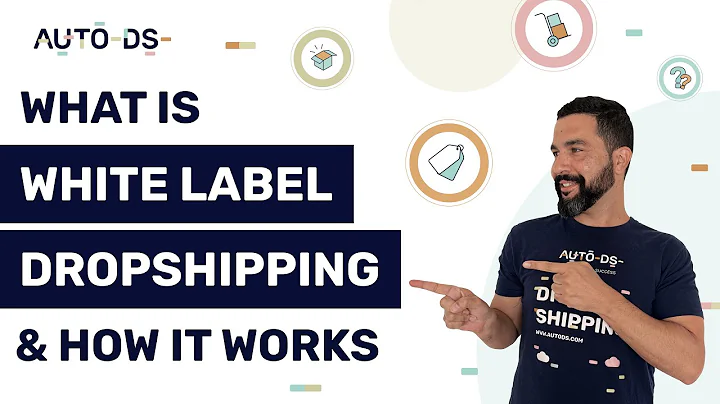The Dark Truth of Dropshipping: No Branding, Fierce Competition, and Reputation Management
Table of Contents:
- Introduction
- The Problem with Drop Shipping
- Lack of Branding Leads to No Return Customers
- Dealing with Copycats and Competition
- Challenges with Reputation Management
- Issues with Payment Processors and AD Account Bans
- The Difficulty of Achieving Longevity
- A Better Alternative: Building a Branded E-Commerce Store
- The Power of Own Branding and Unique Products
- Starting a Clothing Brand: A Viable Option
- Hiring Designers or Learning Design Yourself
- Finding Reliable Manufacturers
- Generating Hype and Using Organic Marketing
- Pre-Orders: A Strategy for Initial Sales
- Conclusion
The Problem with Drop Shipping
dropshipping has emerged as a popular business model for aspiring entrepreneurs. The concept is simple: connect a supplier to buyers and earn a profit by reselling products. Dropshipping seems like a perfect way to make quick money, but the reality is far from it. In this article, we will explore the drawbacks of dropshipping and offer a more lucrative alternative.
1. Lack of Branding Leads to No Return Customers
One of the major downsides of dropshipping is the inability to build a strong brand. With dropshipping, you have no control over product design or quality. This lack of control hampers your ability to create a unique and professional brand. When customers receive subpar products, they are unlikely to return for more. This leads to a lack of repeat customers and tarnishes your reputation. Without branding, you are left with a tacky and unprofessional experience, making it difficult to establish trust and loyalty among your customer base.
2. Dealing with Copycats and Competition
Dropshipping is a highly popular business model, which means you will face fierce competition from other dropshippers selling the same products as you. With little control over the products you sell, it becomes a constant battle of who can market better. This saturation in the market breeds copycats who will imitate your store and products, further increasing the competition. Dealing with copycats and standing out from the crowd becomes increasingly challenging, making it harder to establish a unique selling proposition.
3. Challenges with Reputation Management
Another downside of dropshipping is the constant threat to your reputation. In today's age of social media, anyone can expose dropshippers, leading to a loss of credibility and trust among potential customers. Negative reviews and public exposure can ruin your reputation overnight. Additionally, trolls on platforms like TikTok can easily tarnish your image and spam your comments with accusations of being a scam. This constant battle to maintain a positive reputation becomes exhausting and hinders your ability to build a thriving business.
4. Issues with Payment Processors and AD Account Bans
Dropshippers often face difficulties with payment processors and advertising account bans. Platforms like Facebook and Google prioritize customer experience and crack down heavily on dropshippers. If they discover you are dropshipping, your advertising account may be instantly banned without any explanation. PayPal, a popular payment processor, also poses a challenge for dropshippers. A single bad customer experience or dissatisfaction can result in a frozen PayPal account, causing financial losses and hindering business growth.
5. The Difficulty of Achieving Longevity
Longevity is vital for any business, but it is exceptionally challenging to achieve with dropshipping. The combination of bans from advertising platforms, attacks from trolls, and low-quality products with no branding makes it almost impossible to sustain a dropshipping business in the long run. Dropshippers who manage to thrive often guard their strategies closely, leaving newcomers struggling to find success. If you aspire to build a lasting and prosperous business, dropshipping may not be the best choice.
A Better Alternative: Building a Branded E-Commerce Store
While dropshipping may have its drawbacks, there is a better alternative: building a branded e-commerce store. This approach allows you to establish your own brand, develop unique products, and create a lasting business. Let's explore this alternative in more detail.
1. The Power of Own Branding and Unique Products
Building a branded e-commerce store gives you the opportunity to create your own unique brand that resonates with your target audience. With complete control over product design and quality, you can differentiate yourself from competitors and offer customers a high-quality experience. By developing a strong brand identity, you can foster trust, loyalty, and repeat customers—a crucial ingredient for long-term success.
2. Starting a Clothing Brand: A Viable Option
One viable option within the realm of branded e-commerce stores is starting a clothing brand. Despite the belief that this market is saturated, there is always room for creativity and improvement. You can hire talented and affordable designers from platforms like Upwork or learn design skills through YouTube tutorials. By focusing on creating appealing and unique clothing designs, you can stand out from the competition and attract a loyal customer base.
3. Hiring Designers or Learning Design Yourself
If you lack design skills, don't worry. You can hire talented designers to bring your clothing brand to life. Platforms like Upwork offer a wide range of designers with various styles and expertise. Alternatively, if you have the time and dedication, you can learn design skills yourself through online tutorials. By investing in compelling designs, you can create a visually appealing and desirable clothing brand.
4. Finding Reliable Manufacturers
To produce your clothing line, you need to find reliable manufacturers. Platforms like Alibaba and Instagram offer access to a wide network of manufacturing partners. Communicate your design requirements and order a sample to ensure quality and satisfaction. Once you find reliable manufacturers, you can establish a long-term partnership, ensuring consistent quality for your products.
5. Generating Hype and Using Organic Marketing
When your clothing brand is ready to launch, it's time to generate hype and attract customers. Utilize platforms like TikTok and Instagram to showcase your unique designs and build a community around your brand. Organic marketing, such as social media content and influencer collaborations, can be highly effective in creating initial buzz and driving traffic to your store.
6. Pre-Orders: A Strategy for Initial Sales
Instead of investing in inventory upfront, consider using a pre-order system for your initial sales. This allows you to take orders and collect payment before manufacturing and shipping the products. Although pre-orders may result in longer shipping times, proper communication with customers can mitigate any dissatisfaction. As your brand gains momentum, you can transition to holding inventory for faster shipping and improved customer experience.
Conclusion
While dropshipping may seem like a quick path to success, its limitations and challenges make it difficult to achieve long-term profitability. Building a branded e-commerce store, on the other hand, offers greater control, brand recognition, and the potential for sustained growth. Whether you choose to start a clothing brand or explore other product options, the key is to invest in your brand's uniqueness and customer experience. By focusing on these aspects, you can build a thriving e-commerce business that stands the test of time.
Highlights:
- Dropshipping lacks branding, leading to the absence of repeat customers and professionalism.
- Copycats and competition pose significant challenges for dropshippers.
- Reputation management becomes difficult due to exposure and negative reviews.
- Payment processor and advertising account bans add further complications for dropshippers.
- Achieving longevity in dropshipping is extremely challenging.
- Building a branded e-commerce store offers more control and the opportunity to create a unique brand.
- Starting a clothing brand is a viable option within the branded e-commerce space.
- Hire designers or learn design yourself to create compelling clothing designs.
- Find reliable manufacturers to produce high-quality products.
- Utilize organic marketing and generate hype to attract customers to your brand.
- Consider implementing pre-orders as a strategy for initial sales.
FAQ:
Q: Are all dropshipping courses scams?
A: Not all dropshipping courses are scams, but many lack value and promise quick riches without proper guidance and strategies.
Q: Can I build a successful dropshipping business without branding?
A: Building a successful dropshipping business without branding is extremely difficult as it results in no repeat customers and a lack of professionalism.
Q: Is starting a clothing brand a saturated market?
A: While the clothing market is competitive, there is always room for creativity and unique brand offerings. Standing out and providing exceptional quality can lead to success.
Q: How can I overcome reputation management challenges in dropshipping?
A: Building a strong brand with emphasis on product quality and customer satisfaction can help mitigate reputation management challenges. Promptly addressing customer concerns and maintaining open communication is essential.
Q: Can I use pre-orders in any e-commerce business?
A: Pre-orders can be utilized in various e-commerce businesses, especially when testing new products or managing inventory costs. However, appropriate communication about potential shipping delays is crucial to manage customer expectations.



















